

The City of Xian became a cultural and political center of China with founding of Zhou Dynasty (1122-255 BC)and was established into an imperial Capital by The first Emperor of Han Dynasty, Liu Bang in 202 BC. In the city there are several burial mounds and tombs of the Emperors from Zhou Dynasty and 800 royal mausoleums and tombs from Han Dynasty. It has many important sites and some are ongoing archaeological progress such as The Mausoleum of Qin Shi Huang and his terracotta army. Imperial Tomb site of Tang Emperor Gaozong, Empress Wu-Zetian and various royal Li family members, is one of the many Tang era's mausoleums located in Xian City.


Qianling Mausoleum, lying 85km away from north west of Xian city, was a large burial complex hat contains the joined Mausoleum of Emperor Gaozong (628-683) and his wife Empress Wu-Zetian (624-705) and some of the Royal Li's family. It was built in year 684 and completed with additional construction in year 706 when his wife The Empress Wu-Zetian, the first and the only governing Empress in the history of China who reigned China for 15 years under her own reign name Zhou (690-705), was interred in a joint burial with him. It was very unusual throughout the Chinese history that an Emperor to be buried with his wife, and it was none at all in the world that two great leaders of the same era were sharing one Mausoleum.


Qianling Mausoleum is situated at the northern peak of Liangshan Mountains, 1049 meter above sea level, overlooking the south end of the mountains that is of a much lower height. Lying by its east and west side are two mountains named Nipple Peaks. Covering a total land area of 40 sq. km, the site appears like a sleeping beauty from high elevation. Besides the main tumulus mound and underground tomb of Gaozong and Wu-Zetian, there are another 17 attendant tombs, in which 5 of them have been excavated by archaeologists in 1960s and early 1970s including tombs of Prince Yi-de and Princess Yongtai. Unlike other Tang or Hang's tomb sites, treasures within imperial tombs of Qianling were never stolen by grave robbers.



The Spirit Pathway leading to Qianling Mausoleum was flanked on both sides with massive stone sculptures, including of ornamental pillars, winged beasts, ostriches, horses, winged horses, saddled horse led by grooms, lions, ostriches, officials and guards.



Qianling is famous for its many carved stone statues with distinctive features of Tang Dynasty located above ground along a pathway to Mausoleum as well as the fresco that adorned the passage and subterranean walls of the underground tombs.


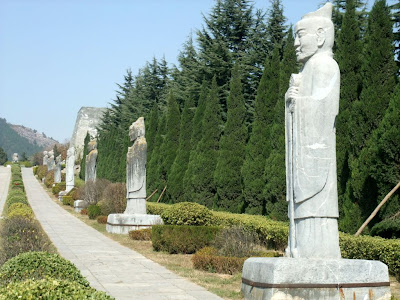
The Stone beast and guards.



The "Uncharactered Stele" built to commemorate The Empress Wu-Zetian stands by the east side of Phoenix Gate within Qianling Burial Complex. It was 6.3 meters tall by 2.1 meter wide with thickness 1.5 meter and weighs 98 ton.




Unlike other tablets, The Stele of Empress Wu-Zetian has no written inscription at all. The vague written wordings on it was from some travelers of Song and Jin Dynasty. It was said that the Stele was erected blank as a term of Empress Wu-Zetian's will reading as " My achievements and errors must be evaluated by later generations, therefore, carve no character on my stele". Others believed that her son could not conceive any appropriate words or phrases to make commentary on her so left no character.




The rear side of the Uncharactered Stele was decorated with some kind of dragon design.




After the watch towers, there are two skillfully sculpted male and female stone lions from Tang Dynasty.



There are 3 stone gates along the entire pathway to mausoleum and each gate has 3 watch towers, one big and two small.



The 61 stone status of foreign diplomats bear witness to The Tang's power, prosperity and its friendly relations with minority people from the surrounding areas and other central Asian countries. They were sculpted in a praying gesture in year 680's and placed here, under the order of Empress Wu-Zetian, to commemorate the minority chieftains and foreign envoys who attended the funeral of her husband Emperor Gaozong.

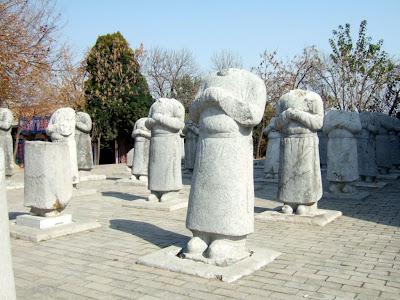

Majority of the 61 stone figures are headless. It was said that their heads were defaced or chopped off by their country folks as they felt downgraded and not so comfortable to see the chief representatives and envoys from their countries becoming guardians of Mausoleum for a dead king and queen of a foreign nation.



The inner Tombs of Royal family were located deep inside the mountain and it could only be reached by horses through a 200 ft long x 13 ft wide tunnel half way up the northern peak.



It was found out that during Tang's period, there were hundreds of residential houses surrounded Qianling Mausoleum, inhabited by families who maintained the grounds and buildings of the tomb site. The Tomb site was enclosed by walls which remains had been discovered together with the remains of those houses.




Holy Merits Recording Tablet was a 7-tiered Stele with a height of 6.3 meter dedicated to Emperor Gaozong. It has an inscription of 8000 characters, conceived by his wife, Empress Wu-Zetian, extolling the military and administrative of his achievement. All inscribed characters and symbols were filled with gold powder. There are two tomb tablets for Gaozong, one only carried his name and the other with the name of Empress Wu-Zetian added.




Among the other three prominent mausoleums in Qianling Burial Complex are tombs for Crown Prince Yi-de (Li-Chongrun), Zhanghuai and Princess Yongtai. Prince Ye-di was the grandson of Emperor Gaozong and Empress Wu-Zetian and was one of the victims of his formidable and self-seeking grandmother. He was sentenced to death at a tender age of 19 for opposing The Empress's autocracy and laid to rest in a grand mausoleum decorated with stone lions and other figurines. Prince Yi-de's Tomb composed of a passage way with 3 arches, 1 shaft, 2 chambers, one behind the other and 7 courtyards together with 8 niches that probably would have accommodate some statues. The whole mausoleum inter-linked by corridors and although the columns were no longer in a piece, the imposing structure of his resting place was a tribute to his importance.



The Mausoleum of Prince Yide extended to a size of about 260 x 215 meter richly endowed with a large numbers of fine artifacts. Over thousand of ceramic and tri-colored figurines, pottery, gold, copper and bronze items were discovered when the tomb was excavated. A remarkable array of murals were also found inside the tomb. There were 40 pieces illustrating his daily life at Tang Court and some illustrating his hunting activity. The most outstanding and precious one is the 2.8 meter long mural "Parade of the Crown Prince" which symbolized the prince with black dragon and white tiger. The mural illustrated a colorful royal possession in Changan (Xian) with guard of honor riding in chariots on horse back and on foot marching and passing by towers, city walls and other important buildings of ancient capital city. The well composed murals were rich and extensive in themes and they were now being conserved and housed by Shaanxi History Museum in Xian.



Within Shaanxi Province, not far from Xian City, there are also 5 important Mausoleum for the Emperors of Han Dynasty (206 BC - 24 AD). The most renowned and the largest is Wu-Di's Maoling Mausoleum. Han-Wu-Di (Liu Che 156-87 BC) was the 5th ruling monarch of West Han Dynasty since his ancestor Lim Bang (256-195BC) defeated Xiang Yu in year 202 BC. He was on throne for 50 years until the age of 70 (140-87 BC), being one of the longest reigning emperors in China's history. Under his rule, Han Dynasty was at the peak of its power and splendor, the country was in prosperity and stability. He opened the trade route (Silk Road) from Gansu Corridor to central Asian countries to promote economy and exchange culture. The famous mission of China's first diplomat Zhang Qian traveling to western regions was happened during his reign and under his order.

Maoling Mausoleum Site is used to be called as The Chinese Pyramid as it was the largest, took longest time in construction, and held the richest burial contents of all Mausoleums built during West Han Dynasty for Emperors. Maoling Museum stores many precious culture relics of West Han Dynasty which provides evidence to the creativity and extensive range of skills in ancient craft during Han Dynasty.


The classic Musical Hall at Maoling Complex exhibited some ancient musical instruments and special performance of ancient music would be shown at the hall upon request.



Maoling Museum focus mainly on the history of West Han Dynasty. It combines the cultural relics and ancient construction within a picturesque garden setting.

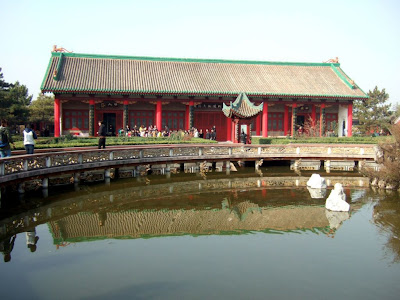

A symbol of a typical Han's royal garden site.



The man-made pond was embarked with dragon designed levee with legendary stone sculpture placed at the water center.



Majority of the unearth artifacts at Maoling Museum were from the Mausoleum and Tomb of Huo-Qubing and many reflects the life and achievement of Emperor Wu-Di.
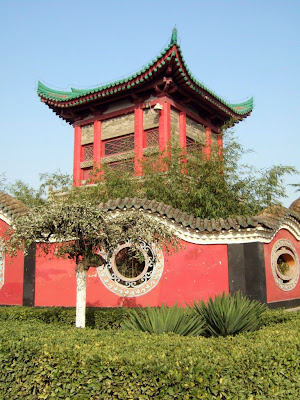


The two great work piece of Han's stone carving crafts. A horse ready to leap possess strong sense of movement and A Hun Intruder hoofed by a warhorse measured 190x168cm in size was a masterpiece, carving on one whole piece of huge rock.


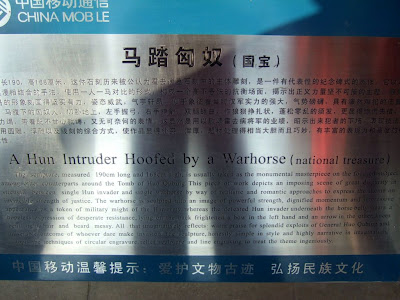

The 18 pieces of magnificent stone carvings discovered from Tomb of Huo-Qubing (140 -117 BC) were the earliest and best preserved stone sculpture in China. Huo-Qubing was a very famous extraordinary talented military expert and a valiant General during the reign of Han Wu-Di. He defeated The Hun at the age of only 21 but unfortunately he suddenly passed away at the age of 23, due to sickness, as per court official announcement. The Emperor buried him at the east side of Maoling. Nevertheless, others suspected that Huo was not dying of sickness but was murdered perhaps under the order of Han Wu-Di as he was young and very strong in military and further with an uncle as a military general and aunt as The Empress. It was said that Han Wu-Di was afraid that one day he would be out of control and might overtake his kingdom after he died. Two years after Huo Qu-bing defeated Han's strongest enemy, he was secretly put to death.




Maoling was about 45 km away from the City of Xian. With more than 20 tombs of imperial wives, meritorious ministers, and worthy nobles at the site, it covers an area of 54,000 sq.meters.



According to burial system regulation in Western Han (232-202 BC), construction of a huge tomb for emperors should begin in the 2nd year of his reign. One third of the royal annual revenue was usually allocated for the construction of the tombs. The mounds of Han Emperors were packed into square shapes with level tops and due to its square slopes, it was usually called as Fangshan. The Mausoleum built during Emperor's lifetime was called Longevity Tomb


Believe it or not, the locals said that whoever is able to throw a penny through these two natural holes at the rock on a small hilly slope, luck would be with him.



The name of Han's great general Huo-Qubing literally means get-rid off sickness. Step onto this piece of huge stone carved with his name, you would probably be free from sickness.



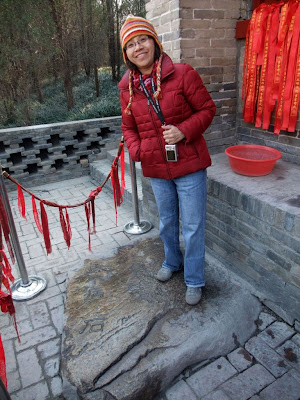
In the museum there is a map illustrating the routes of Zhang Qian traveling to the west regions under the order of Emperor Han-Wudi initially to look for blood-sweated horses, later to promote Han Dynasty and exchange culture. The other important objects shown in the museum is the hollow bricks used in Han Dynasty.



Ancient seals and animal jade figurines were among the unearthed relics.



A set of 4 beautiful knocker base with deities deign and a pair of clay naked figures were unusual items found in the tombs.




Maoling was a square large Mausoleum with 400 meters length in each side surrounded by a park . Emperor Wu-Di began a 53 years building project for his own Mausoleum on the 2nd year after he was enthroned in year 139 BC. It was also recorded that when Emperor Wu-Di died, trees planted on his tomb mound had grown so big that hardly can any man embrace its trunk, as the tomb had already been prepared for over half a century, and there was no more room for any other items as the coffin chamber of Maoling was packed with treasures. During the construction of Hang Wu-Di's Mausoleum, there were about 270,000 rich and powerful people moved from various parts of the country to Maoling site which was called Maoxiang by then. The well known historian of China Sima-Qian was one of them.



Passing by rural counties and villages along the way to Qianling and Maoling sites.

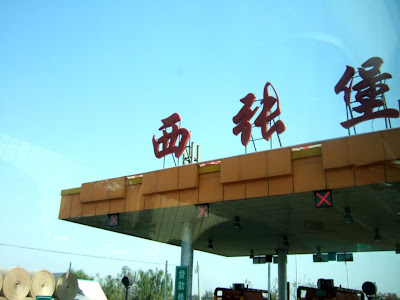
Some interesting sights while passing by the Chinese undeveloped villages:- (1) The joy of getting a bride home celebrated with drums and explosive fire cracker, (2) Tradition dwellings piled with dried maize hanged up at their compound for their animals and poultry, (3) Stalls of raw red dates produced by local farmers.



Vast areas of fruit farms especially the apricot and persimmon at rural sites of Xian City.



No comments:
Post a Comment